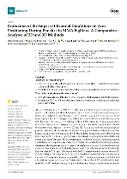Evaluation of the Impact of External Conditions on Arm Positioning During Punches in MMA Fighters: A Comparative Analysis of 2D and 3D Methods

Author
Skalski, Dariusz
Pronczuk, Magdalena
Losinska, Kinga
Drozd, Milosz
Toborek, Michal
Aschenbrenner, Piotr
Maszczyk, Adam
Publication date
2025Published in
SensorsVolume / Issue
25 (11)ISBN / ISSN
ISSN: 1424-8220ISBN / ISSN
eISSN: 1424-8220Metadata
Show full item recordCollections
This publication has a published version with DOI 10.3390/s25113270
Abstract
Mixed Martial Arts (MMA) is a highly dynamic combat sport that requires precise motor coordination and technical execution. Video-based motion analysis, including two-dimensional (2D) and three-dimensional (3D) motion capture systems, plays a critical role in optimizing movement patterns, enhancing training efficiency, and reducing injury risk. However, the comparative validity of 2D and 3D systems for evaluating punching mechanics under external stressors remains unclear. This study aimed to first validate the measurement agreement between 2D and 3D motion analyses during sagittal-plane punches, and second, to examine the impact of fatigue and balance disruption on arm kinematics and punch dynamics in elite MMA athletes. Twenty-one male MMA fighters (mean age: 24.85 +/- 7.24 years) performed standardized straight right punches (SRPs) and swing punches (SPs) under three experimental conditions: normal, balance-disrupted, and fatigued. Participants were instructed to deliver maximal-effort punches targeting a designated striking pad placed at a consistent height and distance. Each punch type was executed three times per condition. Kinematic data were collected using the my Dartfish Express(version 7.2.0) app (2D system) and MaxPRO infrared motion capture system (3D system). Statistical analyses included Pearson's correlation coefficients, one-way analysis of variance (ANOVA), and linear mixed models (LMMs). Strong correlations (r = 0.964-0.999) and high intraclass correlation coefficient (ICC) values (0.81-0.99) confirmed the high reliability of 2D analysis for sagittal-plane techniques. Fatigue significantly decreased punch velocity and impact force (p < 0.01), while increasing joint angle variability (p < 0.01). These findings highlight the complementary use of 2D and 3D motion capture methods, supporting individualized monitoring, adaptive technique evaluation, and performance optimization in combat sports.
Keywords
motion analysis, fatigue, joint angles, punch dynamics, combat sports,
Permanent link
https://hdl.handle.net/20.500.14178/3114License
Full text of this result is licensed under: Creative Commons Uveďte původ 4.0 International






